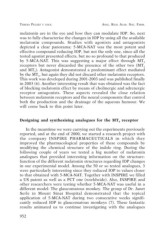Page 142 - 73_04
P. 142
TERESA PELÁEZ Y COLS. ANAL. REAL ACAD. NAC. FARM.
melatonin are in the eye and how they can modulate IOP. So, next
was to fully characterise the changes in IOP by using all the available
melatonin compounds. Studies with agonists and antagonists
depicted a clear panorama: 5-MCA-NAT was the most potent and
effective compound reducing IOP, but not the only one, since all the
tested agonist presented effects, but no so profound to that produced
by 5-MCA-NAT. This was suggesting a major effect through MT3
receptors but never discarded the presence of the other two (MT1
and MT2). Antagonist demonstrated a predominant effect mediated
by the MT3, but again they did not discard other melatonin receptors.
This work was developed during 2001-2003 and was published finally
in 2003 (6). Another interesting result that was obtained was the fact
of blocking melatonin effect by means of cholinergic and adrenergic
receptor antagonists. These aspects revealed the close relation
between melatonin receptors and the neural components that control
both the production and the drainage of the aqueous humour. We
will come back to this point later.
Designing and synthesising analogues for the MT3 receptor
In the meantime we were carrying out the experiments previously
reported, and at the end of 2000, we started a research project with
the company INSPIRE PHARMACEUTICALS in which they
improved the pharmacological properties of these compounds by
modifying the chemical structure of the indole ring. During the
following couple of years we tested a big number of melatonin
analogues that provided interesting information on the structure-
function of the different melatonin structures regarding IOP changes
in our experimental model. Among the 50 or so tested analogues, 3
were particularly interesting since they reduced IOP to values closer
to that obtained with 5-MCA-NAT. Together with INSPIRE we filled
a US patent as well as a PCT one (worldwide). Also, INSPIRE and
other researchers were testing whether 5-MCA-NAT was useful in a
different model: The glaucomatous monkey. The group of Dr. Janet
Serle in Mount Sinai Hospital demonstrated that the topical
application of 5-MCA-NAT during two consecutive weeks signifi-
cantly reduced IOP in glaucomatous monkeys (7). These fantastic
results animated us to continue investigating with the analogues
952

